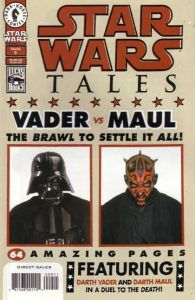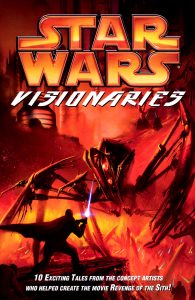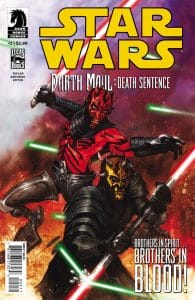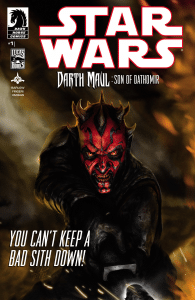One of the biggest surprises for fans coming out of Solo: A Star Wars Story was the return of Darth Maul. Played once again by Ray Parks and Clone Wars and Rebels alum Sam Witmer returning to voice the character, it was revealed in the closing moments of the film that Maul led the shady Crimson Dawn criminal organization. Casual fans and non-nerds unfamiliar with the old expanded universe (now known as Legends) and the new Disney canon were shocked to see the doomed, yet visually pleasing Sith apprentice from The Phantom Menace grace the silver screen once more. After all, the last time most of those folks saw Maul he had been cut in half by a young Obi-Wan Kenobi.
Fans familiar with the animated series Clone Wars and Rebels already knew that Maul had returned. It’s hard to keep a good Sith down, and Maul is one of the few visceral images from the prequels that no one mocks… except for the fact that maybe he should have stuck around longer. Therein lies the crux of the issue: Maul was too cool to stay dead for long!
Like the best mysteries from a galaxy far, far away, the story of how Maul returned goes much deeper. In fact, the return of Maul can be traced back to the Dark Horse comic books. Maul’s return, while rooted in the Legends expanded universe, does have a comic book connection. Curious fans stumbling out of the theater thirsting for more Maul can find his early “return” appearances, both canon and not, in these books.
[bs_smart_list_pack_start][/bs_smart_list_pack_start]
Star Wars Tales #9 (2001)
For the first “return of Darth Maul” story, we have to go all the way back to 2001. Star Wars Tales was an anthology book that featured several one-off stories starring the entire cast of characters from the films and original expanded universe. Some of the stories were lighthearted, some intentionally outside of the canon, and others attempted to consequentially add to the overall fabric of the ever-growing expanded universe.
In “Resurrection,” fans were treated to the ultimate nerd showdown: Darth Vader versus Darth Maul! Vader is lured to a planet where he is tracking down the Rebels who had stolen the Death Star plans (remember, this is all pre-Rogue One). There, Vader is confronted by the Prophets of the Dark Side, who question Vader’s commitment to Palpatine’s cause. The spirits of the dead Sith have resurrected Maul to replace the unworthy Vader. The battle royale that the nerdiest of nerds had been clamouring for since 1999 commenced. I know my friends and I debated it. The story did not disappoint. It was epic!
And… Maul lost. Vader dispatched Maul by igniting his lightsaber through his own body to deliver the killing blow. In a sort of lame “this dialogue could be from the prequels” moment, Maul’s last act was to ask Vader what he could possibly hate enough to muster the will to destroy him. Vader simply responds, “Myself.” Cue angsty prequel Anakin music!
While never intended to be canon, it’s a fun story that took a whole two years to make, which is kind of insane and surprising that it took that long to bring him back given how popular Maul was at the time.
Star Wars Visionaries (2005)
In the month leading up the theatrical release of Revenge of the Sith, Dark Horse did something unfathomable in today’s Star Wars movie climate: Dark Horse released the trade paperback adaptation of the movie several weeks before the movie hit the theaters. I discussed this particular quirk recently when I wrote about Vader’s iconic “NOOOOO!” from Revenge of the Sith. Dark Horse also released a companion book with the trade for Revenge of the Sith called Visionaries.
The collection featured ten non-canon stories that showed off the collected talents of the visual artists who worked on the film. Overall, Visionaries ended up being one of my favorite books from the Dark Horse era. It was fresh, unique, and had a sense of stylistic panache that the actual Star Wars books being published by Dark Horse at the time lacked. Because the stories weren’t canon, the artists took risks exploring areas not commonly seen in Star Wars comics. Bringing Darth Maul back from the dead ended up being one such risk.
ILM artist Aaron McBride brought everyone’s favorite horned menace back in a story called “Old Wounds.” In this story, Maul returns to Tatooine, hunting his nemesis Kenobi. He makes his way to the Lars homestead, where he threatens the young Luke Skywalker. Obi-Wan is of course waiting for Maul. Though Kenobi defeats Maul, he does not outright kill him, though the temptation to do so nearly consumes him. Lars Owen takes the option away by blasting a cap in Maul’s head, ending the conflict.
It’s an interesting story for several reasons. First off, readers can directly see some General Grevious’s concept work in Maul’s legs, as they are nearly identical. It’s a cool nod to the development of the droid army general, and gave rise to the urban legend that Maul was originally intended to be Grevious. The second cool thing about this story is how similar it is to the actual story told in Rebels about the demise of Maul just before A New Hope. Obi-Wan and Maul do meet near the Skywalker homestead, albeit with rather less pazzaz than the throwdown in Visionaries. It was a short story, but it was easily the best from the entire OGN. It gave many fans hope that perhaps someone within the Star Wars infrastructure would run with the idea that Maul should return.
Darth Maul: Death Sentence
Of course, Lucasfilm was listening. Maul’s canon return to the Star Wars universe was during the third season of the fan-favorite animated series The Clone Wars. Dark Horse cashed in on the return with a miniseries, Death Sentence.
The miniseries by Tom Taylor and Bruno Redondo features Maul teaming up with is brother Savage Opress (I swear I did not make that name up), as the two siblings try their hand at murder, mayhem, and crime. The Clone Wars established that Maul was already dabbling in forming his own criminal syndicate while the Clone Wars were still waging across the galaxy. This miniseries explores this notion further by having Maul trying his hand at using a corrupt mining operation as a cover for his shenanigans. It’s inline with what the animated series had already setup for the character. The Clone Wars is still considered to be canon, but this series is not.
Here’s where things get confusing and little bit complicated off-panel. Despite having been directly spun off from the show, it is not considered canon because it was published before the Disney acquisition. In Disney’s reasoning of the new continuity, only the animated series itself is actually canon, not the novels or comics produced in conjunction with the show. Death Sentence, while in no way, shape, or form contradicting anything established in The Clone Wars, is officially Legends.
Simple, right? It’s about to get much more complicated.
Darth Maul: Son of Dathomir
Dark Horse lost the Star Wars comic book license in January 2014 to fellow House of Mouse acquisition Marvel Comics. Throughout 2014, Dark Horse published all of their remaining scheduled Star Wars books. While Disney had already canned The Clone Wars in 2013, jettisoning the planned sixth, seventh, and eighth seasons of the show. With a whopping sixty-five (!!!) episodes already in some form of production, there were many storylines already plotted out, with many already finished with production. One of the final books Dark Horse had lined up was an adaptation of an unfinished Darth Maul story arc intended to air during one of the future seasons.
Son of Dathomir follows Maul’s last onscreen appearance from The Clone Wars in which Maul’s attempts at being a crime boss have gone belly up and he is captured by his former master Darth Sidious. Maul escapes Sidious and Dooku, but ends up bungling any chance for a return to glory with his Mandalorian-backed Shadow Collective crime syndicate (could this be retconned to be Crimson Dawn instead?). The series ends with a defeated Maul who has to once again return to the shadows. And it’s all canon!
Unlike the Death Sentence comic, Son of Dathomir is considered to be canon, earning the dubious honor of being the only new canon book from Dark Horse. How does that work? The difference between Son of Dathomir and Death Sentence is that this miniseries is directly based off scripts of unaired episodes of a canon show. Therefore, Son of Dathomir is canon, whereas Death Sentence was only based on the show and not a direct adaptation. Glad that’s cleared up.
[bs_smart_list_pack_end][/bs_smart_list_pack_end]
“You and I will be working much more closely from now on.”
From his non-canon returns in Star Wars Tales and Visionaries, to his two canon-ish Dark Horse miniseries’ from The Clone Wars, a very much alive and cybernetic Maul has been hanging around your local comic shop for several years now. Of course, don’t limit yourself to reading the comic books simply because they did it first. You owe it to yourself to go back and watch The Clone Wars and Rebels to see where else Maul has showed up post-The Phantom Menace. Death can have little permanence in science fiction, fantasy, comic books, and other geek genres, but Maul’s return was handled with style.
A character this cool can’t be so easily dumped down a shaft on Naboo. Unless we’re talking about Jar-Jar. He could be dumped that easily.

